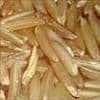Top 10 Healthy High Carb Foods

Carbohydrates are an essential part of a balanced diet, however, some popular diets have unfortunately given 'carbs' a bad reputation and even lead to a 'fear' of carbohydrate foods in recent years.
A balanced diet should always include the three major food groups: carbohydrates, proteins, and fats.
Carbohydrate-rich foods are the body's main source of energy, giving you the fuel you need to carry out your daily activities. The brain also runs on carbohydrates, so this includes mental, as well as physical, energy. Healthy carbohydrate food sources like whole grains and vegetables are also a key dietary source of fiber, vitamins, and minerals.
Choosing the right type of carbohydrate is important. Carbohydrates that should be limited or avoided are the refined carbs, including white bread, white rice, white flour products, and anything with added sugar.
Healthy high-carb foods include sweet potatoes, brown rice, navy beans, chestnuts, lentils, bananas, oatmeal, milk, raisins, and healthy snacks like brown rice cakes. The current daily value (DV) for carbs is 275 grams.
The following is a list of the top 10 healthy sources of carbohydrates to include in your diet. Click here for a list of high carb foods to avoid.
List of Healthy High Carb Foods
 1 Sweet Potatoes
1 Sweet Potatoes| Carbs per Cup Mashed | Carbs per 100g | Carbs per 200 Calories |
|---|---|---|
| 59.1g (22% DV) | 23.2g (8% DV) | 45.9g (17% DV) |
More Vegetables High in Carbs
- 33g (12% DV) per cup of pea sprouts
- 30g (11% DV) per cup of acorn squash
- 27g (10% DV) per cup of sweet corn
- 24g (9% DV) per cup of green peas
 2 Brown Rice
2 Brown Rice| Carbs per Cup | Carbs per 100g | Carbs per 200 Calories |
|---|---|---|
| 51.7g (19% DV) | 25.6g (9% DV) | 41.6g (15% DV) |
More Alternative Grains high in Carbohydrates
- 51g (19% DV) per cup of spelt
- 48g (17% DV) per cup of kamut
- 45g (16% DV) per cup of amaranth
- 45g (16% DV) per cup of pearled barley
- 42g (15% DV) per cup of millet
- 39g (14% DV) per cup of quinoa
- 36g (13% DV) per cup of wild rice
 3 Navy Beans
3 Navy Beans| Carbs per Cup | Carbs per 100g | Carbs per 200 Calories |
|---|---|---|
| 47.4g (17% DV) | 26.1g (9% DV) | 37.2g (14% DV) |
 4 Lentils
4 Lentils| Carbs per Cup | Carbs per 100g | Carbs per 200 Calories |
|---|---|---|
| 39.9g (14% DV) | 20.1g (7% DV) | 34.7g (13% DV) |
 5 Bananas
5 Bananas| Carbs per Cup Sliced | Carbs per 100g | Carbs per 200 Calories |
|---|---|---|
| 34.3g (12% DV) | 22.8g (8% DV) | 51.3g (19% DV) |
 6 Oatmeal
6 Oatmeal| Carbs per Cup | Carbs per 100g | Carbs per 200 Calories |
|---|---|---|
| 28.1g (10% DV) | 12g (4% DV) | 33.8g (12% DV) |
 7 Milk
7 Milk| Carbs per 16oz Glass | Carbs per 100g | Carbs per 200 Calories |
|---|---|---|
| 24.4g (9% DV) | 5g (2% DV) | 23.8g (9% DV) |
Plain Yogurt provides 11g (6% DV) of carbs per cup.
 8 Raisins
8 Raisins| Carbs per Oz | Carbs per 100g | Carbs per 200 Calories |
|---|---|---|
| 20.6g (7% DV) | 79.3g (29% DV) | 53.1g (19% DV) |
More Dried Fruit High in Carbs
- 21g (8% DV) per oz of dates
- 21g (8% DV) per oz of currants
- 21g (8% DV) per oz of dried pears
- 18g (7% DV) per oz of dried apples
- 18g (7% DV) per oz of prunes
- 18g (7% DV) per oz of dried figs
- 18g (7% DV) per oz of dried apricots
- 17g (6% DV) per oz of dried peaches
*Dried Fruit is high in natural fruit sugars, so should be eaten in moderation. A small handful is a sensible portion size.
 9 Chestnuts
9 Chestnuts| Carbs per oz(~3 Chestnuts) | Carbs per 100g | Carbs per 200 Calories |
|---|---|---|
| 15g (5% DV) | 53g (19% DV) | 43.2g (16% DV) |
 10 Brown Rice Cakes
10 Brown Rice Cakes| Carbs per 2 Cakes | Carbs per 100g | Carbs per 200 Calories |
|---|---|---|
| 14.7g (5% DV) | 81.5g (30% DV) | 41.6g (15% DV) |
A wafer of rye crispbread provides 9g (3% DV) carbs.
Printable One Page Sheet

What is the recommended daily allowance (RDA) for Carbohydrates?
The daily value (%DV) for carbohydrates is 275g and is a general target intended for most people. The Recommended Dietary Allowance (RDA) shows specific targets by age and gender. The RDA for carbohydrates is between 60g - 130g for most people.
| Life Stage | RDA |
|---|---|
| Infants | |
| 0-6 months old* | 60g |
| 7-12 months old* | 95g |
| Children | |
| 1-3 years old | 130g |
| 4-8 years old | 130g |
| Males | |
| 9+ years old | 130g |
| Females | |
| 9+ years old | 130g |
| Pregnancy | |
| 14-50 years old | 175g |
| Lactation | |
| 14-50 years old | 210g |
About the Data
Data for the curated food lists comes from the USDA Food Data Central Repository.
You can check our data against the USDA by clicking the (Source) link at the bottom of each food listing.
Note: When checking data please be sure the serving sizes are the same. In the rare case you find any difference, please contact us and we will fix it right away.
About Nutrient Targets
Setting targets can provide a guide to healthy eating.
Some of the most popular targets include:- Daily Value (%DV) - The daily value (%DV) is a general guideline for consumption that will prevent deficiency of a particular nutrient in most people. The %DV refers to the percentage of an amount that's found in a single serving of a food. It also accounts for absorption factors. It is set by the U.S. FDA.
- Recommended Dietary Allowance (%RDA) - The RDA sets an average daily dietary intake level that is sufficient to meet the nutrient requirements of nearly all (97.5%) healthy individuals. It's more specific than the daily value, and varies by age and gender. The RDA is set by the US National Instutites of Health.
- Reference Dietary Intake (%RDI) -The reference dietary intake is similar to the recommended daily allowance, but is specific to age and gender. The RDI for amino acids is set by the U.N. World Health Organization.
- Adequate Intake (%AI) - This value is primarily used in reference to omega-3 and omega-6 fats. The Adequate Intake is set by the U.S. Institute of Medicine. Because there is less evidence to determine the ideal targets for consumption of these nutrients, the specific amount is considered to be less reliable. Using the term Adequate Intake, rather than one of the other terms, helps to emphasize that the ideal intake of that particular nutrient has not yet been scientifically determined.
See the Guide to Recommended Daily Intakes for more information.
Want to set your own targets? Sign up for an account and set custom targets in the daily meal planner.From the Nutrient Ranking Tool
Use the ranking tool links below to select foods and create your own food list to share or print.
- Foods High in Carbohydrates
- Foods Low in Carbohydrates
- Vegetables High in Carbohydrates
- Fruits High in Carbohydrates
- Vegetarian Foods High in Carbohydrates
- Nuts High in Carbohydrates
- Grains High in Carbohydrates
- Beans High in Carbohydrates
- Dairy High in Carbohydrates
- Breakfast Cereals High in Carbohydrates
- Fast Foods High in Carbohydrates
View more nutrients with the nutrient ranking tool, or see ratios with the nutrient ratio tool.
Related
Data Sources and References
Try the recipe nutrition calculator, or daily meal planner.
Create a free account to log and track foods.
